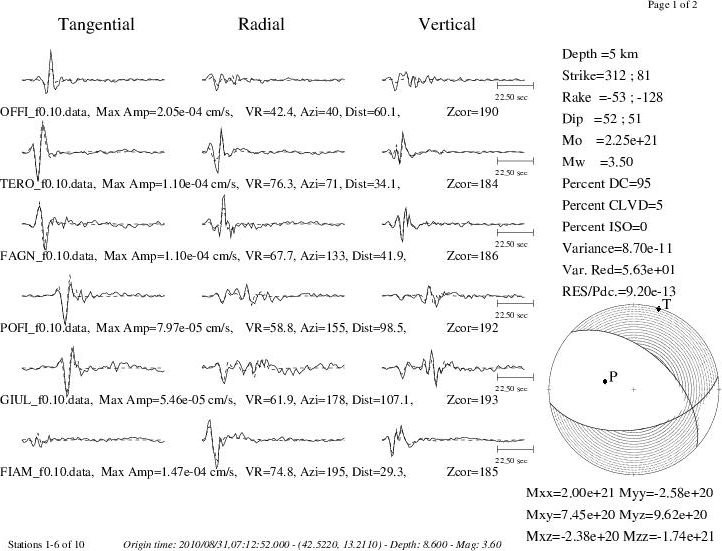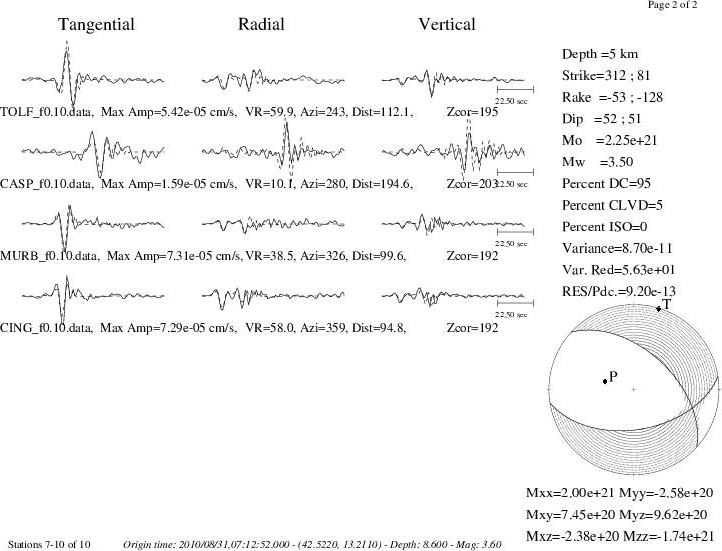Location
2010/08/31 07:12:52 42.522 13.211 8.6 3.6 Italy
Arrival Times (from USGS)
Arrival time list
Felt Map
USGS Felt map for this earthquake
USGS Felt reports page for
Focal Mechanism
USGS/SLU Moment Tensor Solution
ENS 2010/08/31 07:12:52:0 42.52 13.21 8.6 3.6 Italy
Stations used:
IV.ARVD IV.CAMP IV.CERA IV.CERT IV.CESI IV.CING IV.CRE
IV.FAGN IV.FIAM IV.GUMA IV.MGAB IV.MIDA IV.MNS IV.MODR
IV.MURB IV.OFFI IV.PARC IV.PIEI IV.POFI IV.RNI2 IV.RSM
IV.SACS IV.SGG IV.TOLF IV.TRTR MN.AQU
Filtering commands used:
hp c 0.02 n 3
lp c 0.10 n 3
Best Fitting Double Couple
Mo = 2.66e+21 dyne-cm
Mw = 3.55
Z = 5 km
Plane Strike Dip Rake
NP1 310 50 -60
NP2 88 48 -121
Principal Axes:
Axis Value Plunge Azimuth
T 2.66e+21 1 19
N 0.00e+00 23 110
P -2.66e+21 67 287
Moment Tensor: (dyne-cm)
Component Value
Mxx 2.34e+21
Mxy 9.40e+20
Mxz -2.43e+20
Myy -6.60e+19
Myz 9.12e+20
Mzz -2.27e+21
############ T
################ ###
############################
#--------#####################
-----------------#################
---------------------###############
-------------------------#############
----------------------------############
------------------------------##########
-------------- ---------------##########
-------------- P ----------------#########
-------------- ------------------######-
##---------------------------------####---
###--------------------------------#----
#####-----------------------------##----
########---------------------######---
#############--------#############--
#################################-
##############################
############################
######################
##############
Global CMT Convention Moment Tensor:
R T P
-2.27e+21 -2.43e+20 -9.12e+20
-2.43e+20 2.34e+21 -9.40e+20
-9.12e+20 -9.40e+20 -6.60e+19
Details of the solution is found at
http://www.eas.slu.edu/eqc/eqc_mt/MECH.IT/20100831071252/index.html
|
Preferred Solution
The preferred solution from an analysis of the surface-wave spectral amplitude radiation pattern, waveform inversion and first motion observations is
STK = 310
DIP = 50
RAKE = -60
MW = 3.55
HS = 5.0
The waveform inversion is preferred.
Moment Tensor Comparison
The following compares this source inversion to others
| SLU |
INGVTDMT |
USGS/SLU Moment Tensor Solution
ENS 2010/08/31 07:12:52:0 42.52 13.21 8.6 3.6 Italy
Stations used:
IV.ARVD IV.CAMP IV.CERA IV.CERT IV.CESI IV.CING IV.CRE
IV.FAGN IV.FIAM IV.GUMA IV.MGAB IV.MIDA IV.MNS IV.MODR
IV.MURB IV.OFFI IV.PARC IV.PIEI IV.POFI IV.RNI2 IV.RSM
IV.SACS IV.SGG IV.TOLF IV.TRTR MN.AQU
Filtering commands used:
hp c 0.02 n 3
lp c 0.10 n 3
Best Fitting Double Couple
Mo = 2.66e+21 dyne-cm
Mw = 3.55
Z = 5 km
Plane Strike Dip Rake
NP1 310 50 -60
NP2 88 48 -121
Principal Axes:
Axis Value Plunge Azimuth
T 2.66e+21 1 19
N 0.00e+00 23 110
P -2.66e+21 67 287
Moment Tensor: (dyne-cm)
Component Value
Mxx 2.34e+21
Mxy 9.40e+20
Mxz -2.43e+20
Myy -6.60e+19
Myz 9.12e+20
Mzz -2.27e+21
############ T
################ ###
############################
#--------#####################
-----------------#################
---------------------###############
-------------------------#############
----------------------------############
------------------------------##########
-------------- ---------------##########
-------------- P ----------------#########
-------------- ------------------######-
##---------------------------------####---
###--------------------------------#----
#####-----------------------------##----
########---------------------######---
#############--------#############--
#################################-
##############################
############################
######################
##############
Global CMT Convention Moment Tensor:
R T P
-2.27e+21 -2.43e+20 -9.12e+20
-2.43e+20 2.34e+21 -9.40e+20
-9.12e+20 -9.40e+20 -6.60e+19
Details of the solution is found at
http://www.eas.slu.edu/eqc/eqc_mt/MECH.IT/20100831071252/index.html
|
INGV Time Domain Moment Tensor
http://earthquake.rm.ingv.it/tdmt.php


|
Waveform Inversion
The focal mechanism was determined using broadband seismic waveforms. The location of the event and the
and stations used for the waveform inversion are shown in the next figure.

|
|
Location of broadband stations used for waveform inversion
|
The program wvfgrd96 was used with good traces observed at short distance to determine the focal mechanism, depth and seismic moment. This technique requires a high quality signal and well determined velocity model for the Green functions. To the extent that these are the quality data, this type of mechanism should be preferred over the radiation pattern technique which requires the separate step of defining the pressure and tension quadrants and the correct strike.
The observed and predicted traces are filtered using the following gsac commands:
hp c 0.02 n 3
lp c 0.10 n 3
The results of this grid search from 0.5 to 19 km depth are as follow:
DEPTH STK DIP RAKE MW FIT
WVFGRD96 1.0 320 30 -20 3.37 0.3162
WVFGRD96 2.0 320 40 -30 3.40 0.3664
WVFGRD96 3.0 315 50 -50 3.44 0.4279
WVFGRD96 4.0 310 50 -55 3.48 0.4542
WVFGRD96 5.0 310 50 -60 3.55 0.4675
WVFGRD96 6.0 320 55 -45 3.52 0.4480
WVFGRD96 7.0 325 60 -30 3.49 0.4234
WVFGRD96 8.0 330 75 15 3.49 0.4097
WVFGRD96 9.0 330 75 15 3.50 0.4032
WVFGRD96 10.0 330 75 15 3.51 0.3944
WVFGRD96 11.0 330 75 15 3.53 0.3837
WVFGRD96 12.0 330 75 10 3.53 0.3707
WVFGRD96 13.0 330 75 10 3.54 0.3577
WVFGRD96 14.0 160 75 25 3.55 0.3434
WVFGRD96 15.0 160 75 25 3.57 0.3349
WVFGRD96 16.0 160 75 25 3.58 0.3251
WVFGRD96 17.0 160 75 25 3.59 0.3157
WVFGRD96 18.0 160 75 25 3.60 0.3072
WVFGRD96 19.0 160 75 25 3.61 0.2998
WVFGRD96 20.0 160 75 25 3.62 0.2930
WVFGRD96 21.0 160 75 25 3.62 0.2872
WVFGRD96 22.0 160 80 25 3.63 0.2821
WVFGRD96 23.0 160 80 25 3.64 0.2775
WVFGRD96 24.0 160 80 25 3.65 0.2737
WVFGRD96 25.0 160 80 25 3.66 0.2710
WVFGRD96 26.0 160 80 25 3.67 0.2691
WVFGRD96 27.0 160 80 25 3.68 0.2673
WVFGRD96 28.0 160 80 25 3.69 0.2653
WVFGRD96 29.0 325 70 -10 3.70 0.2661
The best solution is
WVFGRD96 5.0 310 50 -60 3.55 0.4675
The mechanism correspond to the best fit is

|
|
Figure 1. Waveform inversion focal mechanism
|
The best fit as a function of depth is given in the following figure:

|
|
Figure 2. Depth sensitivity for waveform mechanism
|
The comparison of the observed and predicted waveforms is given in the next figure. The red traces are the observed and the blue are the predicted.
Each observed-predicted component is plotted to the same scale and peak amplitudes are indicated by the numbers to the left of each trace. The number in black at the rightr of each predicted traces it the time shift required for maximum correlation between the observed and predicted traces. This time shift is required because the synthetics are not computed at exactly the same distance as the observed and because the velocity model used in the predictions may not be perfect.
A positive time shift indicates that the prediction is too fast and should be delayed to match the observed trace (shift to the right in this figure). A negative value indicates that the prediction is too slow.
The bandpass filter used in the processing and for the display was
hp c 0.02 n 3
lp c 0.10 n 3

|
|
Figure 3. Waveform comparison for selected depth
|

|
|
Focal mechanism sensitivity at the preferred depth. The red color indicates a very good fit to thewavefroms.
Each solution is plotted as a vector at a given value of strike and dip with the angle of the vector representing the rake angle, measured, with respect to the upward vertical (N) in the figure.
|
Discussion
Velocity Model
The nnCIA used for the waveform synthetic seismograms and for the surface wave eigenfunctions and dispersion is as follows:
MODEL.01
C.It. A. Di Luzio et al Earth Plan Lettrs 280 (2009) 1-12 Fig 5. 7-8 MODEL/SURF3
ISOTROPIC
KGS
FLAT EARTH
1-D
CONSTANT VELOCITY
LINE08
LINE09
LINE10
LINE11
H(KM) VP(KM/S) VS(KM/S) RHO(GM/CC) QP QS ETAP ETAS FREFP FREFS
1.5000 3.7497 2.1436 2.2753 0.500E-02 0.100E-01 0.00 0.00 1.00 1.00
3.0000 4.9399 2.8210 2.4858 0.500E-02 0.100E-01 0.00 0.00 1.00 1.00
3.0000 6.0129 3.4336 2.7058 0.500E-02 0.100E-01 0.00 0.00 1.00 1.00
7.0000 5.5516 3.1475 2.6093 0.167E-02 0.333E-02 0.00 0.00 1.00 1.00
15.0000 5.8805 3.3583 2.6770 0.167E-02 0.333E-02 0.00 0.00 1.00 1.00
6.0000 7.1059 4.0081 3.0002 0.167E-02 0.333E-02 0.00 0.00 1.00 1.00
8.0000 7.1000 3.9864 3.0120 0.167E-02 0.333E-02 0.00 0.00 1.00 1.00
0.0000 7.9000 4.4036 3.2760 0.167E-02 0.333E-02 0.00 0.00 1.00 1.00
Quality Control
Here we tabulate the reasons for not using certain digital data sets
The following stations did not have a valid response files:
DATE=Tue Aug 31 07:55:05 CDT 2010
Last Changed 2010/08/31






